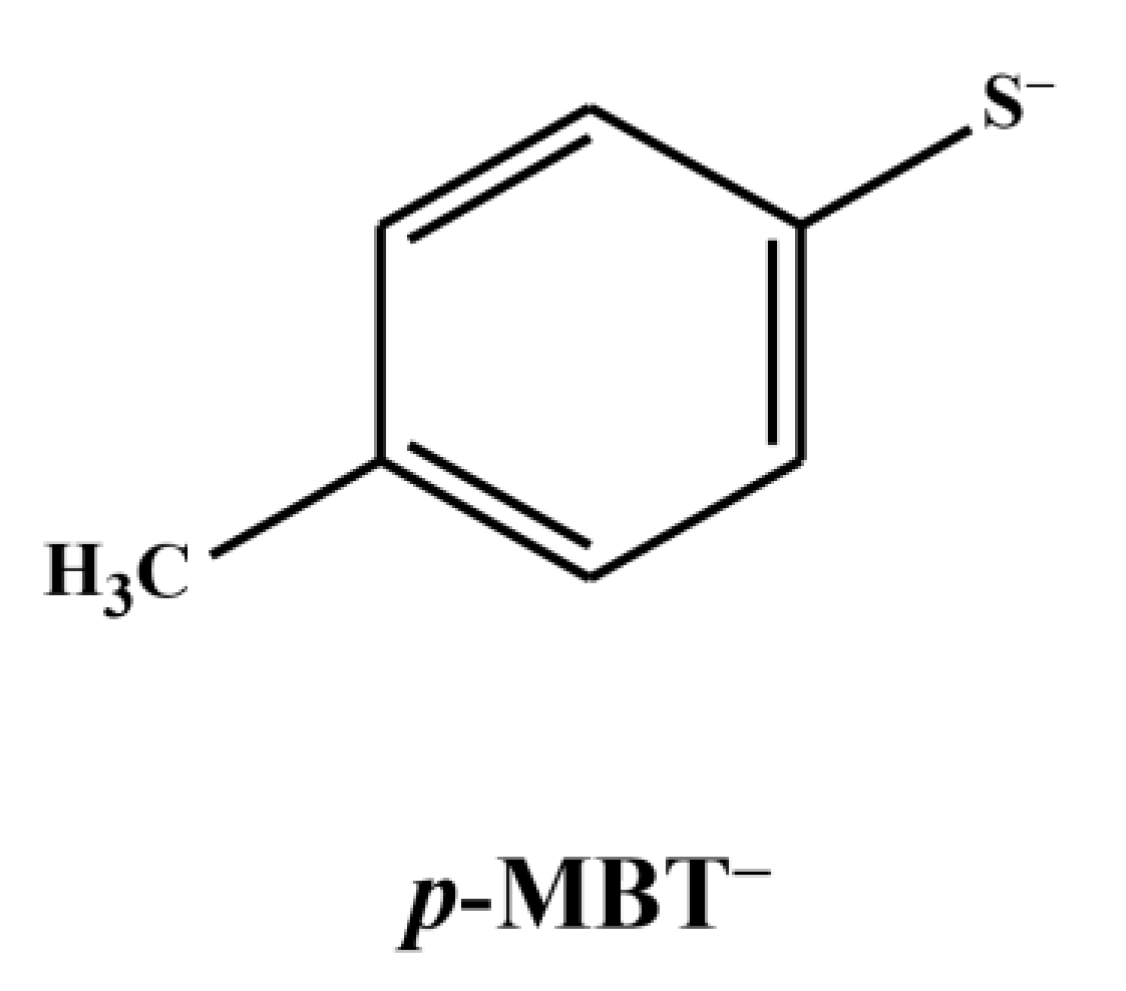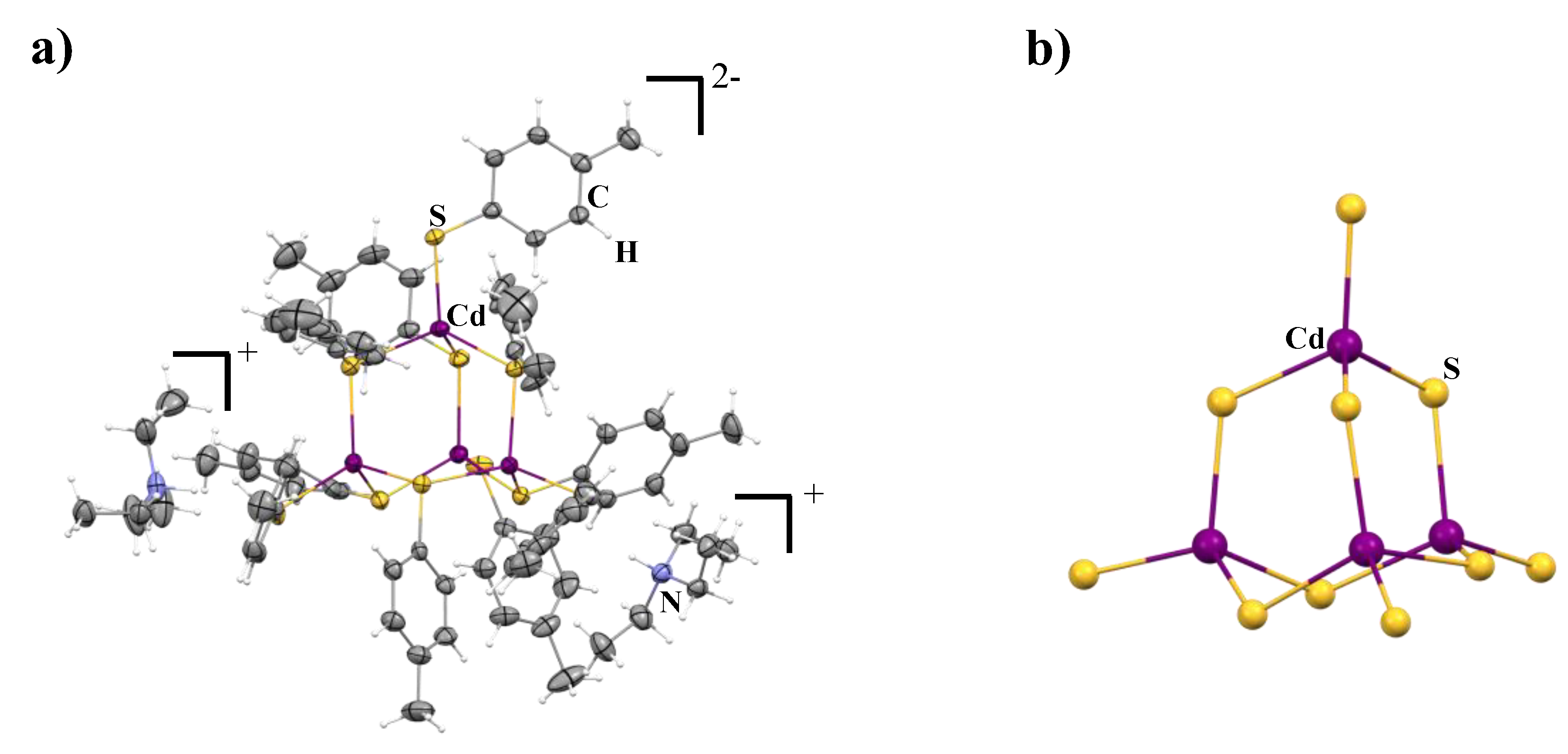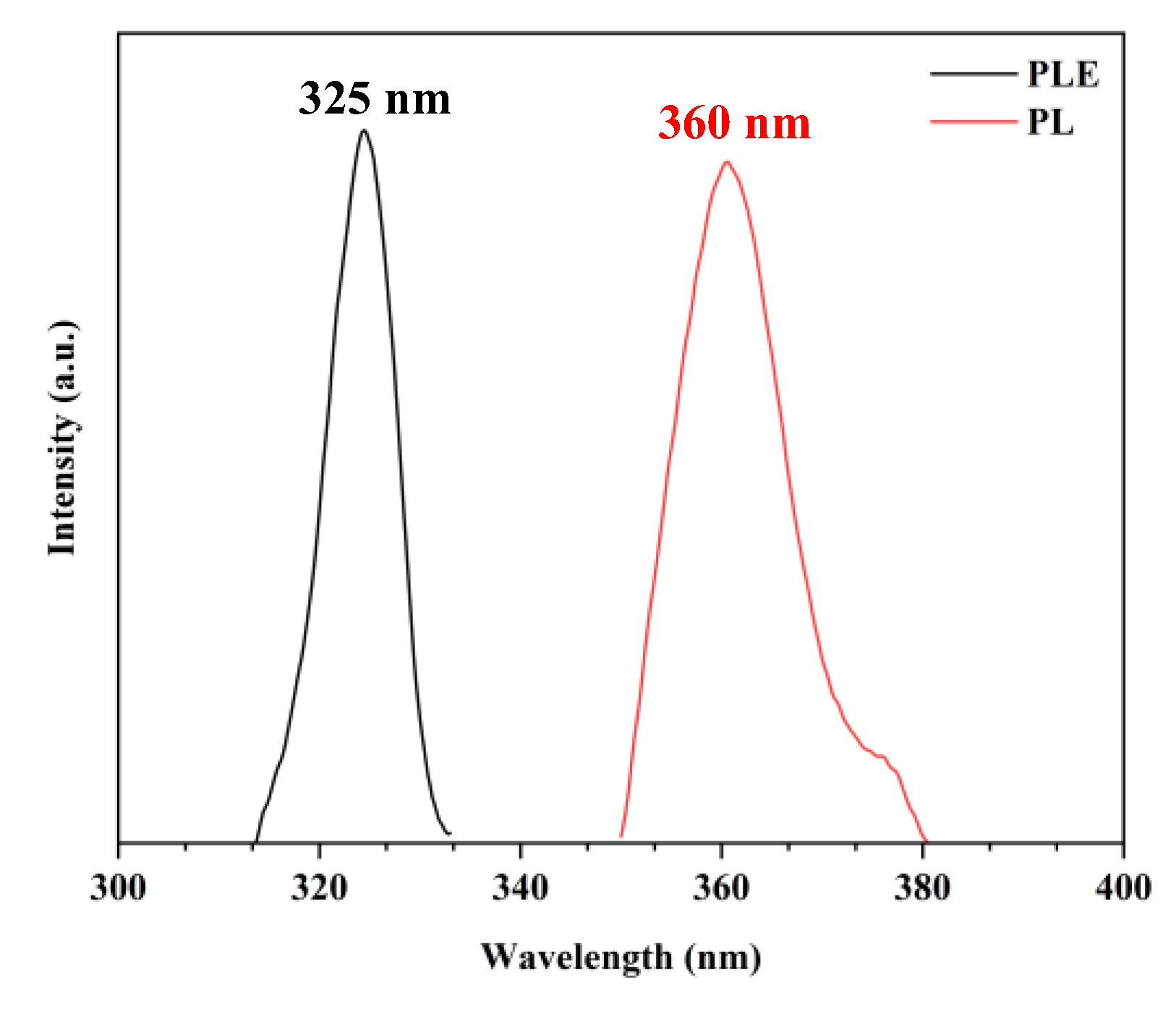Synthesis, Structure, and Optical Properties of a Molecular Cluster Cd4(p-MBT)10
Abstract
:1. Introduction
2. Materials and Methods
2.1. Materials and Measurements
2.2. Synthesis of Cd4(p-MBT)10
2.3. X-ray Crystallographic Procedures
3. Results and Discussion
4. Conclusions
Supplementary Materials
Author Contributions
Funding
Data Availability Statement
Conflicts of Interest
References
- Jin, R.; Zeng, C.; Zhou, M.; Chen, Y. Atomically Precise Colloidal Metal Nanoclusters and Nanoparticles: Fundamentals and Opportunities. Chem. Rev. 2016, 116, 10346–10413. [Google Scholar] [CrossRef] [PubMed]
- Cook, A.W.; Hayton, T.W. Case Studies in Nanocluster Synthesis and Characterization: Challenges and Opportunities. Acc. Chem. Res. 2018, 51, 2456–2464. [Google Scholar] [CrossRef]
- Singh, V.; Priyanka; More, P.V.; Hemmer, E.; Mishra, Y.K.; Khanna, P.K. Magic-Sized CdSe Nanoclusters: A Review on Synthesis, Properties and White Light Potential. Mater. Adv. 2021, 2, 1204–1228. [Google Scholar] [CrossRef]
- Qian, H.; Zhu, M.; Wu, Z.; Jin, R. Quantum Sized Gold Nanoclusters with Atomic Precision. Acc. Chem. Res. 2012, 45, 1470–1479. [Google Scholar] [CrossRef] [PubMed]
- Wei, X.; Xu, C.; Li, H.; Kang, X.; Zhu, M. Fabrication of a Family of Atomically Precise Silver Nanoclusters via Dual-Level Kinetic Control. Chem. Sci. 2022, 13, 5531–5538. [Google Scholar] [CrossRef] [PubMed]
- Li, Q.; Huang, B.; Yang, S.; Zhang, H.; Chai, J.; Pei, Y.; Zhu, M. Unraveling the Nucleation Process from a Au(I)-SR Complex to Transition-Size Nanoclusters. J. Am. Chem. Soc. 2021, 143, 15224–15232. [Google Scholar] [CrossRef]
- Touchton, A.J.; Wu, G.; Hayton, T.W. Understanding the Early Stages of Nickel Sulfide Nanocluster Growth: Isolation of Ni3, Ni4, Ni5, and Ni8 Intermediates. Small 2020, 17, 2003133. [Google Scholar] [CrossRef]
- Zhu, M.; Lanni, E.; Garg, N.; Bier, A.M.E.; Jin, R. Kinetically Controlled, High-Yield Synthesis of Au25 Clusters. J. Am. Chem. Soc. 2008, 130, 1138–1139. [Google Scholar] [CrossRef]
- Zhu, C.; Xin, J.; Li, J.; Li, H.; Kang, X.; Pei, Y.; Zhu, M. Fluorescence or Phosphorescence? The Metallic Composition of the Nanocluster Kernel Does Matter. Angew. Chem. Int. Ed. 2022, 31, e202205947. [Google Scholar] [CrossRef]
- Wan, X.; Wang, J.; Wang, Q.-M. Ligand-Protected Au55 with a Novel Structure and Remarkable CO2 Electroreduction Performance. Angew. Chem. Int. Ed. 2021, 133, 20916–20921. [Google Scholar] [CrossRef]
- Li, Y.; Song, Y.; Zhang, X.; Liu, T.; Xu, T.; Wang, H.; Jiang, D.-E.; Jin, R. Atomically Precise Au42 Nanorods with Longitudinal Excitons for an Intense Photothermal Effect. J. Am. Chem. Soc. 2022, 144, 12381–12389. [Google Scholar] [CrossRef] [PubMed]
- Wu, W.-H.; Zeng, H.-M.; Yu, Z.-N.; Wang, C.; Jiang, Z.-G.; Zhan, C.-H. Unusual Structural Transformation and Luminescence Response of Magic-Size Silver(I) Chalcogenide Clusters via Ligand-Exchange. Chem. Commun. 2021, 57, 13337–13340. [Google Scholar] [CrossRef]
- Jiang, Z.-G.; Wu, W.-H.; Jin, B.-X.; Zeng, H.-M.; Jin, Z.-G.; Zhan, C.-H. A Chloride-Doped Silver-Sulfide Cluster [Ag148S26Cl30(C@CBut)60]6+: Hierarchical Assembly, Enhanced Luminescence and Cytotoxicity to Cancer Cells. Nanoscale 2021, 14, 1971–1977. [Google Scholar] [CrossRef]
- Zhu, M.; Aikens, C.M.; Hollander, F.J.; Schatz, G.C.; Jin, R. Correlating the Crystal Structure of a Thiol-Protected Au25 Cluster and Optical Properties. J. Am. Chem. Soc. 2008, 130, 5883–5885. [Google Scholar] [CrossRef] [PubMed]
- Jadzinsky, P.D.; Calero, G.; Ackerson, C.J.; Bushnell, D.A.; Kornberg, R.D. Structure of a Thiol Monolayer-Protected Gold Nanoparticle at 1.1 A Resolution. Science 2007, 318, 430–433. [Google Scholar] [CrossRef] [PubMed]
- Chen, Y.; Liu, C.; Tang, Q.; Zeng, C.; Higaki, T.; Das, A.; Jiang, D.-E.; Rosi, N.L.; Jin, R. Isomerism in Au28(SR)20 Nanocluster and Stable Structures. J. Am. Chem. Soc. 2016, 138, 1482–1485. [Google Scholar] [CrossRef]
- Gary, D.C.; Flowers, S.E.; Kaminsky, W.; Petrone, A.; Li, X.; Cossairt, B.M. Single-Crystal and Electronic Structure of a 1.3 nm Indium Phosphide Nanocluster. J. Am. Chem. Soc. 2016, 138, 1510–1513. [Google Scholar] [CrossRef]
- Li, Q.; Zhou, M.; So, W.Y.; Huang, J.; Li, M.; Kauffman, D.R.; Cotlet, M.; Higaki, T.; Peteanu, L.A.; Shao, Z.; et al. A Mono-Cuboctahedral Series of Gold Nanoclusters: Photoluminescence Origin, Large Enhancement, Wide Tunability, and Structure–Property Correlation. J. Am. Chem. Soc. 2019, 141, 5314–5325. [Google Scholar] [CrossRef]
- Liang, X.-Q.; Li, Y.-Z.; Wang, Z.; Zhang, S.-S.; Liu, Y.-C.; Cao, Z.-Z.; Feng, L.; Gao, Z.-Y.; Xue, Q.-W.; Tung, C.-H.; et al. Revealing the Chirality Origin and Homochirality Crystallization of Ag14 Nanocluster at the Molecular Level. Nat. Commun. 2021, 12, 1–10. [Google Scholar] [CrossRef]
- Zeng, Y.; Havenridge, S.; Gharib, M.; Baksi, A.; Weerawardene, K.L.D.M.; Ziefuß, A.R.; Strelow, C.; Rehbock, C.; Mews, A.; Barcikowski, S.; et al. Impact of Ligands on Structural and Optical Properties of Ag29 Nanoclusters. J. Am. Chem. Soc. 2021, 143, 9405–9414. [Google Scholar] [CrossRef]
- Shen, H.; Xu, Z.; Wang, L.; Han, Y.; Liu, X.; Malola, S.; Teo, B.K.; Häkkinen, H.; Zheng, N. Tertiary Chiral Nanostructures from C−H···F Directed Assembly of Chiroptical Superatoms. Angew. Chem. Int. Ed. 2021, 133, 22585–22590. [Google Scholar] [CrossRef]
- Li, Y.; Higaki, T.; Du, X.; Jin, R. Chirality and Surface Bonding Correlation in Atomically Precise Metal Nanoclusters. Adv. Mater. 2020, 32, 1905488. [Google Scholar] [CrossRef] [PubMed]
- Kang, X.; Zhu, M. Tailoring the Photoluminescence of Atomically Precise Nanoclusters. Chem. Soc. Rev. 2019, 48, 2422–2457. [Google Scholar] [CrossRef]
- Du, X.; Jin, R. Atomically Precise Metal Nanoclusters for Catalysis. ACS Nano 2019, 13, 7383–7387. [Google Scholar] [CrossRef] [PubMed]
- Ghosh, A.; Mohammed, O.F.; Bakr, O.M. Atomic-Level Doping of Metal Clusters. Acc. Chem. Res. 2018, 51, 3094–3103. [Google Scholar] [CrossRef]
- Kang, X.; Li, Y.; Zhu, M.; Jin, R. Atomically Precise Alloy Nanoclusters: Syntheses, Structures, and Properties. Chem. Soc. Rev. 2020, 49, 6443–6514. [Google Scholar] [CrossRef]
- Beecher, A.N.; Yang, X.; Palmer, J.H.; LaGrassa, A.L.; Juhas, P.; Billinge, S.J.L.; Owen, J.S. Atomic Structures and Gram Scale Synthesis of Three Tetrahedral Quantum Dots. J. Am. Chem. Soc. 2014, 136, 10645–10653. [Google Scholar] [CrossRef]
- SAINT. Part of Bruker APEX3 Software Package (version 2016.9-0); Bruker AXS: Billerica, MA, USA, 2016. [Google Scholar]
- SADABS. Part of Bruker APEX3 Software Package (version 2016.9-0); Bruker AXS: Billerica, MA, USA, 2016. [Google Scholar]
- Sheldrick, G.M. SHELXT—Integrated Space-Group and Crystal-Structure Determination. Acta Crystallogr. Sect. A Found. Adv. 2015, 71, 3–8. [Google Scholar] [CrossRef]
- Sheldrick, G.M. Crystal Structure Refinement with SHELXL. Acta Crystallogr. Sect. C Struct. Chem. 2015, C71, 3–8. [Google Scholar] [CrossRef]
- Hencher, J.; Khan, M.A.; Said, F.F.; Tuck, D.G. The Direct Electrochemical Synthesis and Crystal Structure of Salts of [M4(SC6H5)10]2− Anions (M = Zn, Cd). Polyhedron 1985, 4, 1263–1267. [Google Scholar] [CrossRef]
- Sugiuchi, M.; Shichibu, Y.; Konishi, K. An Inherently Chiral Au24 Framework with Double-Helical Hexagold Strands. Angew. Chem. Int. Ed. 2018, 57, 7855–7859. [Google Scholar] [CrossRef] [PubMed]
- Moreland, A.C.; Rauchfuss, T.B. Synthesis, Structure, and Reactivity of a Remarkable Iron Sulfide: (TACN)2Fe2S6. J. Am. Chem. Soc. 1998, 120, 9376–9377. [Google Scholar] [CrossRef]
- Baba, T.; Okamura, T.; Yamamoto, H.; Yamamoto, T.; Ueyama, N. Zinc, Cadmium, and Mercury 1,2-Benzenedithiolates with Intramolecular NH···S Hydrogen Bonds. Inorg. Chem. 2008, 47, 2837–2848. [Google Scholar] [CrossRef] [PubMed]
- Kato, M.; Kojima, K.; Okamura, T.; Yamamoto, H.; Yamamura, T.; Ueyama, N. Relation between Intramolecular NH···S Hydrogen Bonds and Coordination Number in Mercury(II) Complexes with Carbamoylbenzenethiol Derivatives. Inorg. Chem. 2005, 44, 4037–4044. [Google Scholar] [CrossRef]
- François, S.; Rohmer, M.-M.; Bénard, M.; Moreland, A.C.; Rauchfuss, T.B. The N−H···S Hydrogen Bond in (TACN)2Fe2S6 (TACN = Triazacyclononane) and in Model Systems Involving the Persulfido Moiety: An ab Initio and DFT Study. J. Am. Chem. Soc. 2000, 122, 12743–12750. [Google Scholar] [CrossRef]
- Zhou, J.; Peng, Y.; Zhang, Y.; Li, B.; Zhang, Y. Synthesis, Crystal Structure and Luminescent Properties of a Novel Cadmium Coordination Polymer with Unprecedented One-Dimensional Hetero-Triple-Stranded Chain. Inorg. Chem. Commun. 2004, 7, 1181–1183. [Google Scholar] [CrossRef]
- Zhang, X.; Tian, Y.; Jin, F.; Wu, J.; Xie, Y.; Tao, X.; Jiang, M. Self-Assembly of an Organic Chromophore with Cd−S Nanoclusters: Supramolecular Structures and Enhanced Emissions. Cryst. Growth Des. 2005, 5, 565–570. [Google Scholar] [CrossRef]
- Jiang, J.-B.; Bian, G.-Q.; Zhang, Y.-P.; Luo, W.; Zhu, Q.-Y.; Dai, J. Anion–Cation Charge-Transfer Properties and Spectral Studies of [M(phen)3][Cd4(SPh)10] (M = Ru, Fe, and Ni). Dalton Trans. 2011, 40, 9551–9556. [Google Scholar] [CrossRef] [PubMed]
- Tang, X.-Y.; Yuan, R.-X.; Chen, J.-X.; Zhao, W.; Zheng, A.-X.; Yu, M.; Li, H.-X.; Ren, Z.-G.; Lang, J.-P. Group 12 Metal Zwitterionic Thiolate Compounds: Preparation and Structural Characterization. Dalton Trans. 2012, 41, 6162–6172. [Google Scholar] [CrossRef]
- Xu, C.; Shi, H.-T.; Xin, Z.-F.; Jia, A.-Q.; Zhang, Q.-F. Ligand-Participated Formation of Covalent Superlattices Containing [Cd4(μ-SPh)6] Cores with Adamantane-Like Stereochemistry. J. Clust. Sci. 2014, 25, 1353–1361. [Google Scholar] [CrossRef]
- Xu, Y.-N.; Ching, W.Y. Electronic, Optical, and Structural Properties of Some Wurtzite Crystals. Phys. Rev. B 1993, 48, 4335–4351. [Google Scholar] [CrossRef] [PubMed]
- Ulrich, F.; Zachariasen, W. XIV. Über die Kristallstruktur des «- und ß-CdS, sowie des Wurtzits. Z. Krist. - Cryst. Mater. 1925, 62, 260–273. [Google Scholar] [CrossRef]
- Han, H.; Yao, Y.; Bhargava, A.; Wei, Z.; Tang, Z.; Suntivitch, J.; Voznyy, O.; Robinson, R.D. Tertiary Hierarchical Complexity in Assemblies of Sulfur-Bridged Metal Chiral Clusters. J. Am. Chem. Soc. 2020, 142, 14495–14503. [Google Scholar] [CrossRef] [PubMed]
- Zeng, C.; Chen, Y.; Kirschbaum, K.; Lambright, K.J.; Jin, R. Emergence of Hierarchical Structural Complexities in Nanoparticles and Their Assembly. Science 2016, 354, 1580–1584. [Google Scholar] [CrossRef]
- Ashfaq, M.; Ali, A.; Tahir, M.N.; Khalid, M.; Assiri, M.A.; Imran, M.; Munawar, K.S.; Habiba, U. Synthetic Approach to Achieve Halo Imine Units: Solid-State Assembly, DFT Based Electronic and Non Linear Optical Behavior. Chem. Phys. Lett. 2022, 803, 139843–139851. [Google Scholar] [CrossRef]
- Haroon, M.; Akhtar, T.; Yousuf, M.; Tahir, M.N.; Rasheed, L.; Zahra, S.S.; Haq, I.U.; Ashfaq, M. Synthesis, Crystal Structure, Hirshfeld Surface Investigation and Comparative DFT Studies of Ethyl 2-[2-(2-nitrobenzylidene)hydrazinyl] thiazole-4-carboxylate. BMC Chem. 2022, 16, 1–17. [Google Scholar] [CrossRef] [PubMed]
- Frisch, M.J.; Trucks, G.W.; Schlegel, H.B.; Scuseria, G.E.; Robb, M.A.; Cheeseman, J.R.; Scalmani, G.; Barone, V.; Mennucci, B.; Petersson, G.A.; et al. Gaussian 09, Revision D.01; Gaussian, Inc.: Wallingford, CT, USA, 2013. [Google Scholar]
- Adams, R.D.; Zhang, B.; Murphy, C.J.; Yeung, L.K. Halide Enhancement of the Luminescence of Cd10S4 Thiolate Clusters. Chem. Commun. 1999, 383–384. [Google Scholar] [CrossRef]
- Herron, N.; Calabrese, J.C.; Farneth, W.E.; Wang, Y. Crystal Structure and Optical Properties of Cd32S14(SC6H5)36·DMF4, a Cluster with a 15 Angstrom CdS Core. Science 1993, 259, 1426–1428. [Google Scholar] [CrossRef]
- Xue, X.; Wang, X.S.; Wang, L.Z.; Xiong, R.G.; Abrahams, B.F.; You, X.Z.; Xue, Z.L.; Che, C.M. Hydrothermal Preparation of Novel Cd(II) Coordination Polymers Employing 5-(4-Pyridyl)tetrazolate as a Bridging Ligand. Inorg. Chem. 2002, 41, 6544–6546. [Google Scholar] [CrossRef]
- Thomas, B.; Jose, E.T.; Chacko, J.K.; Divya, K.V. Green Light Emitting Cadmium Sulfide Nanoparticles with Coral Surface Morphology. J. Clust. Sci. 2021, 1–13. [Google Scholar] [CrossRef]







| Compound | [(HNEt3)]2[Cd4(p-MBT)10] |
|---|---|
| Empirical formula | C82H102Cd4N2S10 |
| Formula weight | 1885.85 |
| Temperature (K) | 193.00 |
| Wavelength (Ǻ) | 0.71073 |
| Crystal system | Monoclinic |
| Space group | P21/n |
| a (Å) | 13.4250(4) |
| b (Å) | 42.2528(11) |
| c (Å) | 15.5838(5) |
| α (°) | 90 |
| β (°) | 98.8170(10) |
| γ (°) | 90 |
| V (Å3) | 8735.4(4) |
| Z | 4 |
| ρcalcd (g·cm−3) | 1.434 |
| µ (mm−1) | 1.240 |
| F(000) | 3840 |
| Crystal size (mm) | 0.2 × 0.1 × 0.05 |
| θ range for data collection (°) | 2.378–33.621 |
| Reflections collected | 252515 |
| Independent reflections | 42272 [Rint = 0.0779] |
| Transmission factors (min/max) | 1/0.917 |
| Data/restraints/params. | 42272/497/992 |
| R1, a wR2 b(I > 2σ(I)) | 0.0550/0.0953 |
| R1, a wR2 b (all data) | 0.0849/0.1047 |
| Quality-of-fit c | 1.081 |
| Largest diff. peak and hole (ē·Å−3) | 0.827 and −0.625 |
| Compound. | Sp. Gr. | M − S a (Å) | M − S b (Å) |
|---|---|---|---|
| [(HNEt3)]2[Cd4(p-MBT)10] | P21/n | 2.475(7) | 2.558(6) |
| [A]2[Cd4(SPh)10] [39] | P-1 | 2.460(3) | 2.555(3) |
| [Fe(phen)3][Cd4(SPh)10] [40] | P-1 | 2.467(2) | 2.560(2) |
| [Cd4(Tab)10](PF6)8 [41] | P-1 | 2.4542(8) | 2.5470(8) |
| [(NMe4)]2(Cd4(SPh)9Cl) [42] | P-1 | 2.465(2) | 2.5505(2) |
| [(HNEt3)]2[Zn4(SPh)10] [32] | P-1 | 2.286(6) | 2.370(1) |
| -CdS (wurtzite) [43] | P63mc | 2.518 | 2.532 |
| -CdS (zinc blende) [44] | F-43m | 2.520 | |
Publisher’s Note: MDPI stays neutral with regard to jurisdictional claims in published maps and institutional affiliations. |
© 2022 by the authors. Licensee MDPI, Basel, Switzerland. This article is an open access article distributed under the terms and conditions of the Creative Commons Attribution (CC BY) license (https://creativecommons.org/licenses/by/4.0/).
Share and Cite
Xu, C.; Zhou, Z.; Han, H. Synthesis, Structure, and Optical Properties of a Molecular Cluster Cd4(p-MBT)10. Crystals 2022, 12, 1236. https://doi.org/10.3390/cryst12091236
Xu C, Zhou Z, Han H. Synthesis, Structure, and Optical Properties of a Molecular Cluster Cd4(p-MBT)10. Crystals. 2022; 12(9):1236. https://doi.org/10.3390/cryst12091236
Chicago/Turabian StyleXu, Cheng, Zheng Zhou, and Haixiang Han. 2022. "Synthesis, Structure, and Optical Properties of a Molecular Cluster Cd4(p-MBT)10" Crystals 12, no. 9: 1236. https://doi.org/10.3390/cryst12091236
APA StyleXu, C., Zhou, Z., & Han, H. (2022). Synthesis, Structure, and Optical Properties of a Molecular Cluster Cd4(p-MBT)10. Crystals, 12(9), 1236. https://doi.org/10.3390/cryst12091236








